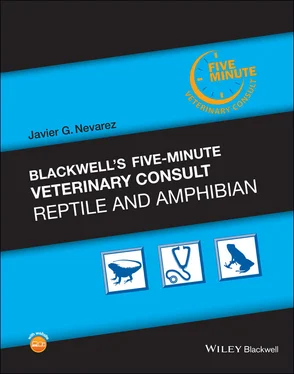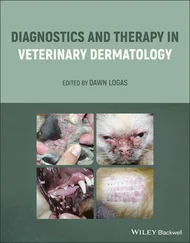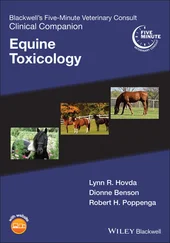The motile feeding trophozoite can also encyst and then be passed through the host’s GI tract and out in the feces.
Trophozoites undergo encystation in which infective cysts are formed and then excreted in feces.
Cysts can remain infective for 14+ days at temperatures of 8 degrees C and several days at 37 degrees C.
It was first considered that chelonians were only carriers and E. invadens were commensal parasites, but there is sufficient evidence that the parasite can affect and cause mortality in all chelonians, including terrestrial chelonians, freshwater and sea turtles.
The disease process causes severe necrotizing colitis, hepatic and pancreatic necrosis with associated granulomas.
Clinical signs occur approximately 2–10 weeks prior to death.
All ages can be affected. Animals consistently kept in temperatures between 25–33 degrees C.
Carnivorous chelonians appear to be more susceptible versus herbivorous chelonians.
Herbivorous chelonians can be asymptomatic carriers.
Anorexia
Diarrhea
Dehydration
Weight loss
Bloody and mucoid stools
Hardening of the large intestinal tract that can be palpated.
Intussusception
Vomiting
Sudden death
Improper husbandry and hygiene, diarrhea, housed with infected animals, decreased immune status, temperatures held between 25 and 33 degrees C.
Invertebrates (i.e., roaches and flies) act as mechanical vectors.
N/A
 DIAGNOSIS
DIAGNOSIS
DIFFERENTIAL DIAGNOSIS
Salmonellosis
GI helminths
Microscopic evaluation of fresh fecal material to visualize trophozoites and cysts.
Trophozoites may be seen in fresh fecal but die rapidly within 20–30 minutes once outside the host.
SAF technique can be used for better visualization.
Fecal/cysts can be placed within a petri dish with water and trophozoites will emerge from the dissolved envelope within several hours.
Immunohistochemistry with E. invadens poly clonal antibody is developed for snakes.
Polymerase chain reaction assays can be used to distinguish species of Entamoeba.
Gross changes include thickening, edema, erosions, ulcers, and diphtheritic membranes of the large intestine.
Liver abscesses may also be seen.
Histologically, the primary finding is fibrinonecrotic colitis.
 TREATMENT
TREATMENT
APPROPRIATE HEALTH CARE
N/A
Nutritional supplementation may be indicated if diarrhea, dehydration is severe.
CLIENT EDUCATION/HUSBANDRY RECOMMENDATIONS
Practice proper hygiene
Wash fruits and vegetables before being fed.
Do not house infected individuals with non‐infected chelonians.
 MEDICATIONS
MEDICATIONS
DRUG(S) OF CHOICE
Metronidazole 25 mg/kg PO q24h for 5–7 days
N/A
 FOLLOW‐UP
FOLLOW‐UP
PATIENT MONITORING
Monitor for weight gain
Take fecal samples
EXPECTED COURSE AND PROGNOSIS
Good
 MISCELLANEOUS
MISCELLANEOUS
COMMENTS
E. invadens in culture, dies at 37 degrees C, so can raise the temperature to 37 degrees C if it is within the animal’s preferred optimum temperature range.
E. histolytica and E. dispar, which are found in humans GI tracts, are morphologically similar to E. invadens but are considered to be non‐pathogenic.
ZOONOTIC POTENTIAL Unknown
SYNONYMS Amebiasis
GI = gastrointestinal
SAF = Sodium acetate acetic acid formalin
de Cardenas C. Amebiasis in Reptiles. PetMD, October 1, 2008. www.petmd.com/reptile/conditions/digestive/c_rp_amebiasis• Amebiasis in Snakes. Wag! 2020. https://wagwalking.com/reptile/condition/amebiasis‐in‐snakes
Divers SJ. Parasitic Diseases of Reptiles. MSD Manual Veterinary Manual, June 2020. www.merckvetmanual.com/exotic‐
and‐laboratory‐animals/reptiles/parasitic‐ diseases‐of‐reptiles
1 Denver MC. Reptile protozoa. In: Fowler
2 M, Miller E, eds. Zoo and Wildlife Medicine: Current Therapy 6. St. Louis, MO: Elsevier Saunders ; 2008:154–159. Hnizdo J, Pantchev N., eds. Protozoa (digestive tract). In: Medical Care of Turtles and Tortoises. Diagnosis. Surgery. Pathology.
3 Parasitology. Frankfurt, Germany: Edition Chimaira; 2011:194–195.
4 Jacobson ER. Parasites and parasitic diseases of reptiles. In: Jacobson ER, ed. Infectious Diseases and Pathology of Reptiles: Color Atlas and Text. Boca Raton, FL: CRC Press; 2007:571–665.
AuthorElsburgh O. Clarke III, DVM, DACZM
Exophthalmia
 BASICS
BASICS
DEFINITION/OVERVIEW
Exophthalmia is the anterior protrusion of a normal‐sized globe.
Space‐occupying swelling or mass in the orbit placing pressure on the globe, displacing it anteriorly.
There is no standard signalment for this disease.
Gradual protrusion of the eye, possibly preventing blinking, and potentially anorexia are common findings in the history.
While it can be bilateral, exophthalmia is more commonly unilateral.
The displacement of the globe will often push the eyelids forward and cause protrusion of the nictitans, and excessive conjunctiva will be visible.
Retropulsion of the globe is met with resistance due to the presence of retrobulbar swelling.
Inadequate husbandry, especially hypothermia, may predispose animals to this condition due to decreased immune function leading to retrobulbar cellulitis and/or abscessation.
Hypovitaminosis A in chelonians causes squamous metaplasia of the orbital glands and ducts, as well as decreased immune function, and may present as bilateral exophthalmia.
N/A
 DIAGNOSIS
DIAGNOSIS
Читать дальше

 DIAGNOSIS
DIAGNOSIS TREATMENT
TREATMENT MEDICATIONS
MEDICATIONS FOLLOW‐UP
FOLLOW‐UP MISCELLANEOUS
MISCELLANEOUS BASICS
BASICS










